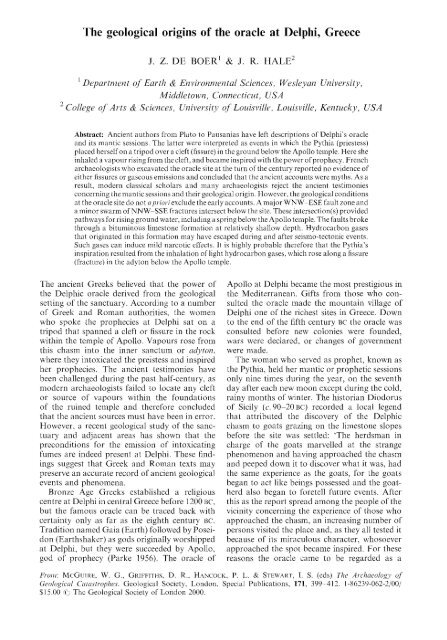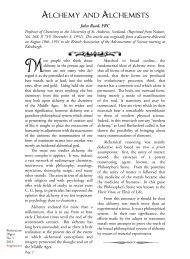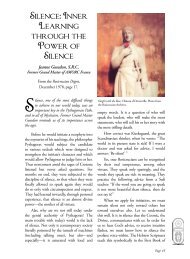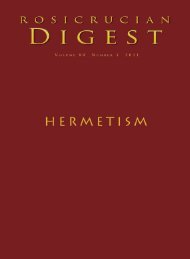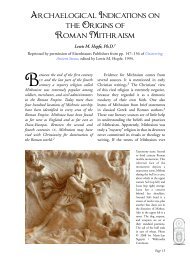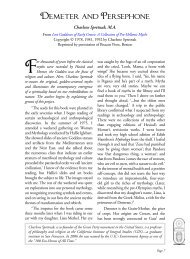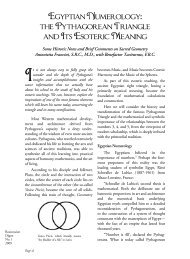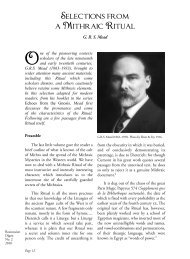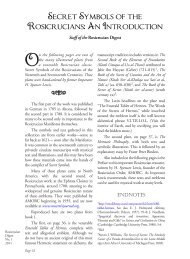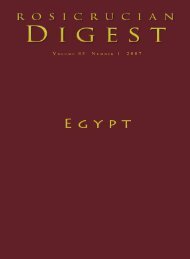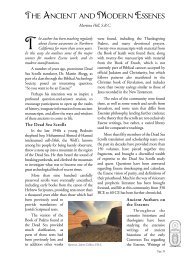The geological origins of the oracle at Delphi, Greece
The geological origins of the oracle at Delphi, Greece
The geological origins of the oracle at Delphi, Greece
You also want an ePaper? Increase the reach of your titles
YUMPU automatically turns print PDFs into web optimized ePapers that Google loves.
<strong>The</strong> <strong>geological</strong> <strong>origins</strong> <strong>of</strong> <strong>the</strong> <strong>oracle</strong> <strong>at</strong> <strong>Delphi</strong>, <strong>Greece</strong><br />
J. Z. DE BOER' & J. R. HALE 2<br />
I Department <strong>of</strong> Earth & Environmental Sciences, Wesleyan University,<br />
Middletown, Connecticut, USA<br />
2 College <strong>of</strong> Arts & Sciences, University <strong>of</strong> Louisville. Louisville, Kentucky, USA<br />
Abstract: Ancient authors from Pl<strong>at</strong>o to Pausanias have left descriptions <strong>of</strong> <strong>Delphi</strong>'s <strong>oracle</strong><br />
and its mantic sessions. <strong>The</strong> l<strong>at</strong>ter were interpreted as events in which <strong>the</strong> Pythia (priestess)<br />
placed herselfon a tripod over a cleft (fissure) in <strong>the</strong> ground below <strong>the</strong> Apollo temple. Here she<br />
inhaled a vapour rising from <strong>the</strong> cleft, and became inspired with <strong>the</strong> power <strong>of</strong> prophecy. French<br />
archaeologists who excav<strong>at</strong>ed <strong>the</strong> <strong>oracle</strong> site <strong>at</strong> <strong>the</strong> turn <strong>of</strong> <strong>the</strong> century reported no evidence <strong>of</strong><br />
ei<strong>the</strong>r fissures or gaseous emissions and concluded th<strong>at</strong> <strong>the</strong> ancient accounts were myths. As a<br />
result, modern classical scholars and many archaeologists reject <strong>the</strong> ancient testimonies<br />
concerning <strong>the</strong> mantic sessions and <strong>the</strong>ir <strong>geological</strong> origin. However, <strong>the</strong> <strong>geological</strong> conditions<br />
<strong>at</strong> <strong>the</strong> <strong>oracle</strong> site do not a priori exclude <strong>the</strong> early accounts. A major WNW-ESE fault zone and<br />
a minor swarm <strong>of</strong> NNW-SSE fractures intersect below <strong>the</strong> site. <strong>The</strong>se intersection(s) provided<br />
p<strong>at</strong>hways for rising ground w<strong>at</strong>er, including a spring below <strong>the</strong> Apollo temple. <strong>The</strong> faults broke<br />
through a bituminous limestone form<strong>at</strong>ion <strong>at</strong> rel<strong>at</strong>ively shallow depth. Hydrocarbon gases<br />
th<strong>at</strong> origin<strong>at</strong>ed in this form<strong>at</strong>ion may have escaped during and after seismo-tectonic events.<br />
Such gases can induce mild narcotic effects. 11 is highly probable <strong>the</strong>refore th<strong>at</strong> <strong>the</strong> Pythia's<br />
inspir<strong>at</strong>ion resulted from <strong>the</strong> inhal<strong>at</strong>ion <strong>of</strong> light hydrocarbon gases, which rose along a fissure<br />
(fracture) in <strong>the</strong> adyton below <strong>the</strong> Apollo temple.<br />
Apollo <strong>at</strong> <strong>Delphi</strong> became <strong>the</strong> most prestigious in<br />
<strong>the</strong> Mediterranean. Gifts from those who con<br />
sulted <strong>the</strong> <strong>oracle</strong> made <strong>the</strong> mountain village <strong>of</strong><br />
<strong>Delphi</strong> one <strong>of</strong> <strong>the</strong> richest sites in <strong>Greece</strong>. Down<br />
to <strong>the</strong> end <strong>of</strong> <strong>the</strong> fifth century BC <strong>the</strong> <strong>oracle</strong> was<br />
consulted before new colonies were founded,<br />
wars were declared, or changes <strong>of</strong> government<br />
were made.<br />
<strong>The</strong> woman who served as prophet, known as<br />
<strong>the</strong> Pythia, held her mantic or prophetic sessions<br />
only nine times during <strong>the</strong> year, on <strong>the</strong> seventh<br />
day after each new moon except during <strong>the</strong> cold,<br />
rainy months <strong>of</strong> winter. <strong>The</strong> historian Diodorus<br />
<strong>of</strong> Sicily (c.90-20BC) recorded a local legend<br />
th<strong>at</strong> <strong>at</strong>tributed <strong>the</strong> discovery <strong>of</strong> <strong>the</strong> <strong>Delphi</strong>c<br />
chasm to go<strong>at</strong>s grazing on <strong>the</strong> limestone slopes<br />
before <strong>the</strong> site was settled: <strong>The</strong> herdsman in<br />
charge <strong>of</strong> <strong>the</strong> go<strong>at</strong>s marvelled <strong>at</strong> <strong>the</strong> strange<br />
phenomenon and having approached <strong>the</strong> chasm<br />
and peeped down it to discover wh<strong>at</strong> it was, had<br />
<strong>the</strong> same experience as <strong>the</strong> go<strong>at</strong>s, for <strong>the</strong> go<strong>at</strong>s<br />
began to act like beings possessed and <strong>the</strong> goa<strong>the</strong>rd<br />
also began to foretell future events. After<br />
this as <strong>the</strong> report spread among <strong>the</strong> people <strong>of</strong> <strong>the</strong><br />
vicinity concerning <strong>the</strong> experience <strong>of</strong> those who<br />
approached <strong>the</strong> chasm, an increasing number <strong>of</strong><br />
persons visited <strong>the</strong> place and, as <strong>the</strong>y all tested it<br />
because <strong>of</strong> its miraculous character, whosoever<br />
approached <strong>the</strong> spot became inspired. For <strong>the</strong>se<br />
reasons <strong>the</strong> <strong>oracle</strong> came to be regarded as a<br />
<strong>The</strong> ancient Greeks believed th<strong>at</strong> <strong>the</strong> power <strong>of</strong><br />
<strong>the</strong> <strong>Delphi</strong>c <strong>oracle</strong> derived from <strong>the</strong> <strong>geological</strong><br />
setting <strong>of</strong> <strong>the</strong> sanctuary. According to a number<br />
<strong>of</strong> Greek and Roman authorities, <strong>the</strong> women<br />
who spoke <strong>the</strong> prophecies <strong>at</strong> <strong>Delphi</strong> s<strong>at</strong> on a<br />
tripod th<strong>at</strong> spanned a cleft or fissure in <strong>the</strong> rock<br />
within <strong>the</strong> temple <strong>of</strong> Apollo. Vapours rose from<br />
this chasm into <strong>the</strong> inner sanctum or adyton.<br />
where <strong>the</strong>y intoxic<strong>at</strong>ed <strong>the</strong> preistess and inspired<br />
her prophecies. <strong>The</strong> ancient testimonies have<br />
been challenged during <strong>the</strong> past half-century, as<br />
modern archaeologists failed to loc<strong>at</strong>e any cleft<br />
or source <strong>of</strong> vapours within <strong>the</strong> found<strong>at</strong>ions<br />
<strong>of</strong> <strong>the</strong> ruined temple and <strong>the</strong>refore concluded<br />
th<strong>at</strong> <strong>the</strong> ancient sources must have been in error.<br />
However, a recent <strong>geological</strong> study <strong>of</strong> <strong>the</strong> sanctuary<br />
and adjacent areas has shown th<strong>at</strong> <strong>the</strong><br />
preconditions for <strong>the</strong> emission <strong>of</strong> intoxic<strong>at</strong>ing<br />
fumes are indeed present <strong>at</strong> <strong>Delphi</strong>. <strong>The</strong>se findings<br />
suggest th<strong>at</strong> Greek and Roman texts may<br />
preserve an accur<strong>at</strong>e record <strong>of</strong> ancient geologica]<br />
events and phenomena.<br />
Bronze Age Greeks established a religious<br />
centre <strong>at</strong> <strong>Delphi</strong> in central <strong>Greece</strong> before 1200 Be,<br />
but <strong>the</strong> famous <strong>oracle</strong> can be traced back with<br />
certainty only as far as <strong>the</strong> eighth century BC.<br />
Tradition named Gaia (Earth) followed by Poseidon<br />
(Earthshaker) as gods originally worshipped<br />
<strong>at</strong> <strong>Delphi</strong>, but <strong>the</strong>y were succeeded by Apollo,<br />
god <strong>of</strong> prophecy (Parke 1956). <strong>The</strong> <strong>oracle</strong> <strong>of</strong><br />
From: MCGUTRE, W. G., GRIFFITHS, D. R., HANCOCK, P. L. & STEWART, 1. S. (eds) <strong>The</strong> Archaeology <strong>of</strong><br />
Geological C<strong>at</strong>astrophes. Geological Society, London, Special Public<strong>at</strong>ions, 171, 399- 412. 1-86239-062-2/00/<br />
$15.00 ((; <strong>The</strong> Geological Society <strong>of</strong> London 2000.
400 J. Z. DE BOER & J. R. HALE<br />
marvel and to be considered <strong>the</strong> prophecy-giving<br />
shrine <strong>of</strong> Earth' (Diodorus Siculus, 1952).<br />
<strong>The</strong> geographer Strabo (c. 64 BC-AD 25) also<br />
wrote a description <strong>of</strong> <strong>the</strong> <strong>oracle</strong> th<strong>at</strong> was instituted<br />
<strong>at</strong> <strong>Delphi</strong>, and <strong>the</strong> <strong>geological</strong> conditions<br />
associ<strong>at</strong>ed with it: '<strong>The</strong>y say th<strong>at</strong> <strong>the</strong> se<strong>at</strong> <strong>of</strong> <strong>the</strong><br />
<strong>oracle</strong> is a cave th<strong>at</strong> is hollowed out deep down<br />
in <strong>the</strong> earth, with a ra<strong>the</strong>r narrow mouth, from<br />
which arises bre<strong>at</strong>h (pneuma) th<strong>at</strong> inspires a<br />
divine frenzy; and th<strong>at</strong> over <strong>the</strong> mouth is placed<br />
a high tripod, mounting which <strong>the</strong> pythian<br />
priestess receives <strong>the</strong> bre<strong>at</strong>h and <strong>the</strong>n utters<br />
<strong>oracle</strong>s in both verse and prose' (Strabo 1927).<br />
Many o<strong>the</strong>r writers referred to <strong>the</strong> chasm and<br />
vapour, including Cicero and Pliny <strong>the</strong> Elder.<br />
One source added an additional element to <strong>the</strong><br />
<strong>geological</strong> background <strong>of</strong> <strong>the</strong> Apollo temple and<br />
its surroundings: '<strong>The</strong>y say th<strong>at</strong> <strong>the</strong> w<strong>at</strong>er <strong>of</strong><br />
Cassotis spring plunges underground and in <strong>the</strong><br />
adyton (inner sanctum) makes <strong>the</strong> women<br />
prophetic' (Pausanias 1935). Pausanias was a<br />
travel writer and religious scholar <strong>of</strong> <strong>the</strong> second<br />
century AD, who described <strong>the</strong> site and <strong>the</strong><br />
monuments <strong>of</strong> <strong>Delphi</strong>, including <strong>the</strong> Cassotis<br />
spring on <strong>the</strong> slope above <strong>the</strong> temple <strong>of</strong> Apollo.<br />
<strong>The</strong> tradition <strong>of</strong> a cavern or narrow cave-mouth<br />
linked to <strong>the</strong> <strong>oracle</strong> <strong>of</strong> A polIo goes back much<br />
earlier, however, to <strong>the</strong> poets Pindar and<br />
Aeschylus in <strong>the</strong> fifth century Be. Even <strong>the</strong><br />
philosopher Pl<strong>at</strong>o (c. 429-347 BC) made a cryptic<br />
reference to '<strong>the</strong> rock' as <strong>the</strong> source <strong>of</strong> prophetic<br />
power <strong>at</strong> <strong>Delphi</strong>: 'It was when <strong>the</strong>y were mad<br />
th<strong>at</strong> <strong>the</strong> prophetess <strong>at</strong> <strong>Delphi</strong> and <strong>the</strong> priestesses<br />
<strong>at</strong> Dodona achieved so much for which both<br />
st<strong>at</strong>es and individuals in <strong>Greece</strong> are thankful;<br />
when sane <strong>the</strong>y did little or nothing ... <strong>The</strong><br />
authorities <strong>of</strong> <strong>the</strong> temple <strong>of</strong> Zeus <strong>at</strong> Dodona say<br />
th<strong>at</strong> <strong>the</strong> first prophetic utterances came from an<br />
oak tree. In fact <strong>the</strong> people <strong>of</strong> those days were<br />
content in <strong>the</strong>ir simplicity to listen to <strong>the</strong> oak<br />
tree and <strong>the</strong> rock, provided <strong>the</strong>se spoke <strong>the</strong><br />
truth' (Pl<strong>at</strong>o 1989).<br />
<strong>The</strong> most valuable ancient source on <strong>the</strong><br />
<strong>Delphi</strong>c <strong>oracle</strong> is <strong>the</strong> Greek philosopher and<br />
essayist Plutarch (c. AD 50-120), who actually<br />
served <strong>at</strong> one time as priest <strong>of</strong> Apollo in <strong>the</strong><br />
temple <strong>at</strong> <strong>Delphi</strong>. Plutarch was thus not only an<br />
eyewitness <strong>of</strong> <strong>the</strong> Pythia's performance, but also<br />
an insider familiar with <strong>the</strong> <strong>oracle</strong>'s oper<strong>at</strong>ions<br />
and traditions. <strong>The</strong> story <strong>of</strong> <strong>the</strong> goa<strong>the</strong>rd discovering<br />
<strong>the</strong> chasm was known to him, and he<br />
actually cites <strong>the</strong> name <strong>of</strong> <strong>the</strong> man involved, a<br />
certain Koretas. Plutarch also knew th<strong>at</strong> <strong>the</strong><br />
Pythia drank w<strong>at</strong>er from <strong>the</strong> spring before each<br />
prophetic session.<br />
Shortly before Plutarch arrived <strong>at</strong> <strong>Delphi</strong> an<br />
extraordinary incident had occurred, which was<br />
reported to him by <strong>the</strong> temple <strong>of</strong>ficials. Plutarch<br />
rel<strong>at</strong>es <strong>the</strong> story to make <strong>the</strong> point th<strong>at</strong> <strong>the</strong> mind<br />
<strong>of</strong> <strong>the</strong> prophet must be in a receptive st<strong>at</strong>e for<br />
<strong>the</strong> vapour (pneuma) to have its proper effect.<br />
A deput<strong>at</strong>ion from abroad had arrived <strong>at</strong> <strong>Delphi</strong><br />
to consult <strong>the</strong> <strong>oracle</strong>, and <strong>the</strong> priests in <strong>the</strong>ir<br />
eagerness to please <strong>the</strong>se visitors ignored <strong>the</strong> ill<br />
omens and compelled <strong>the</strong> Pythia to prophesy:<br />
'She went down into <strong>the</strong> <strong>oracle</strong> unwillingly, <strong>the</strong>y<br />
say, and half-heartedly; and <strong>at</strong> her first responses<br />
it was <strong>at</strong> once plain from <strong>the</strong> harshness <strong>of</strong> her<br />
voice th<strong>at</strong> she was not responding properly; she<br />
was like a labouring ship and was filled with a<br />
mighty and baleful spirit. Finally she became<br />
hysterical and with a frightful shriek rushed<br />
towards <strong>the</strong> exit and threw herself down, with<br />
<strong>the</strong> result th<strong>at</strong> not only <strong>the</strong> members <strong>of</strong> <strong>the</strong><br />
deput<strong>at</strong>ion fled, but also <strong>the</strong> <strong>oracle</strong>-interpreter<br />
Nicander and those holy men th<strong>at</strong> were present.<br />
However, after a little, <strong>the</strong>y went in and took her<br />
up, still conscious; and she lived on for a few<br />
days' (Plutarch 1936).<br />
In old age, Plutarch wrote an essay known as<br />
De defectu oraculorum (On <strong>the</strong> obsolescence <strong>of</strong><br />
<strong>the</strong> <strong>oracle</strong>s) in which he specul<strong>at</strong>es on <strong>the</strong><br />
reasons for <strong>the</strong> weakening <strong>of</strong> <strong>the</strong> prophetic<br />
power <strong>at</strong> <strong>Delphi</strong>. His explan<strong>at</strong>ion is expressed<br />
in almost purely physical and <strong>geological</strong> terms.<br />
First, he considers how veins <strong>of</strong> silver, copper<br />
and asbestos may disappear when <strong>the</strong>y have<br />
been exhausted through mining oper<strong>at</strong>ions.<br />
<strong>The</strong>n he suggests th<strong>at</strong> this disappearance may<br />
serve as an analogy for <strong>the</strong> disappearance <strong>of</strong> <strong>the</strong><br />
vapour: 'Plainly <strong>the</strong> same sober opinion is to<br />
be held regarding <strong>the</strong> spirits (pneum<strong>at</strong>a) th<strong>at</strong><br />
inspire prophecy; <strong>the</strong> power th<strong>at</strong> <strong>the</strong>y possess is<br />
not everlasting and ageless, but is subject to<br />
changes. For excessive rains most likely extinguish<br />
<strong>the</strong>m, and <strong>the</strong>y probably are dispersed by<br />
thunderbolts, and especially, when <strong>the</strong> earth is<br />
shaken bene<strong>at</strong>h by an earthquake and suffers<br />
subsidence and ruinous confusion in its<br />
deptns, <strong>the</strong> exhal<strong>at</strong>ions shift <strong>the</strong>ir site or find<br />
completely blind outlets, as in this place<br />
[<strong>Delphi</strong>] <strong>the</strong>y say th<strong>at</strong> <strong>the</strong>re are still traces <strong>of</strong> th<strong>at</strong><br />
gre<strong>at</strong> earthquake which overthrew <strong>the</strong> city'<br />
(Plutarch 1936).<br />
In spite <strong>of</strong><strong>the</strong>se changes, Plutarch had himself<br />
experienced an unusual phenomenon in <strong>the</strong><br />
adyton <strong>of</strong> <strong>the</strong> Apollo temple, which he <strong>of</strong>fered<br />
as evidence th<strong>at</strong> <strong>the</strong> exhal<strong>at</strong>ions still emerged <strong>at</strong><br />
<strong>the</strong> site <strong>of</strong> <strong>the</strong> <strong>oracle</strong> although <strong>the</strong>y fluctu<strong>at</strong>ed<br />
in intensity: 'I think, <strong>the</strong>n, th<strong>at</strong> <strong>the</strong> exhal<strong>at</strong>ion<br />
is not in <strong>the</strong> same st<strong>at</strong>e all <strong>the</strong> time, but th<strong>at</strong> it<br />
has recurrent periods <strong>of</strong> weakness and strength.<br />
Of <strong>the</strong> pro<strong>of</strong> on which I depend I have as<br />
witnesses many foreigners and all <strong>the</strong> <strong>of</strong>ficials<br />
and servants <strong>at</strong> <strong>the</strong> shrine. It is a fact th<strong>at</strong> <strong>the</strong><br />
room in which <strong>the</strong>y se<strong>at</strong> those who would
GEOLOGICAL ORIGINS OF THE DELPHIC ORACLE<br />
401<br />
consult <strong>the</strong> god is filled. not frequently or with<br />
any regularity, but as it may chance from time to<br />
time, with a delightful fragrance coming on a<br />
current <strong>of</strong> air which bears it towards <strong>the</strong> worshippers,<br />
as if its source were in <strong>the</strong> holy <strong>of</strong><br />
holies (adyton)' (Plutarch, M oralia 1936).<br />
Not one ancient source denied <strong>the</strong> existence <strong>of</strong><br />
<strong>the</strong> chasm and vapour <strong>at</strong> <strong>Delphi</strong>, and thanks to<br />
Plutarch <strong>the</strong> st<strong>at</strong>ements <strong>of</strong> those writers who had<br />
not actually visited <strong>Delphi</strong> <strong>the</strong>mselves are supported<br />
by <strong>the</strong> first-hand evidence <strong>of</strong> an important<br />
<strong>of</strong>ficial within <strong>the</strong> temple hierarchy. Yet<br />
<strong>the</strong> ancient testimony concerning <strong>the</strong> <strong>geological</strong><br />
<strong>origins</strong> <strong>of</strong> <strong>the</strong> <strong>Delphi</strong>c <strong>oracle</strong> has been almost<br />
universally rejected by modern classical scholars<br />
and archaeologists. One influential monograph<br />
on <strong>Delphi</strong> st<strong>at</strong>es th<strong>at</strong> '<strong>geological</strong>ly it is quite<br />
impossible <strong>at</strong> <strong>Delphi</strong> where <strong>the</strong> limestone and<br />
schist could not have emitted a gas with any<br />
intoxic<strong>at</strong>ing properties' (Parke & Wormell 1956,<br />
p.22). Ano<strong>the</strong>r declares th<strong>at</strong> 'a close study <strong>of</strong><br />
all reliable evidence for <strong>Delphi</strong>c mantic procedures<br />
reveals no chasm or vapors, no frenzy <strong>of</strong><br />
<strong>the</strong> Pythia, no incoherent cries interpreted by<br />
priests' (Fontenrose 1978. p. 10); an opinion<br />
echoed by Morgan (1990) and Maass (1993)<br />
<strong>The</strong> primary source <strong>of</strong> <strong>the</strong> current scholarly<br />
opinions is a book on <strong>Delphi</strong>c prophetic procedure<br />
by Amandry (1950), who cited <strong>the</strong> failure<br />
<strong>of</strong> archaeologists to discover a chasm under <strong>the</strong><br />
Apollo temple. In addition, from a <strong>geological</strong><br />
standpoint, he noted th<strong>at</strong> <strong>the</strong> area around<br />
<strong>Delphi</strong> was not volcanic, and declared th<strong>at</strong> it<br />
was <strong>the</strong>refore incapable <strong>of</strong> producing mephitic<br />
vapours (Amandry 1950, pp.196-230). This<br />
neg<strong>at</strong>ive view gained widespread acceptance,<br />
despite <strong>the</strong> fact th<strong>at</strong> <strong>the</strong> French excav<strong>at</strong>ors had<br />
not actually reached bedrock under <strong>the</strong> found<strong>at</strong>ions<br />
<strong>of</strong> <strong>the</strong> temple (Darcque 1991, pp. 689-690).<br />
Amandry also failed to consider <strong>the</strong> possibility<br />
<strong>of</strong> non-volcanic sources <strong>of</strong> vapours. A recent<br />
<strong>geological</strong> study <strong>of</strong> a temple <strong>of</strong> Apollo in Turkey<br />
has reopened <strong>the</strong> question <strong>of</strong> <strong>the</strong> credibility <strong>of</strong><br />
ancient writers such as Strabo and Pausanias.<br />
In examining <strong>the</strong> site <strong>of</strong> an ancient temple <strong>at</strong><br />
Hierapolis (Pamukkalc), a US team was able<br />
to demonstr<strong>at</strong>e th<strong>at</strong> Strabo's description <strong>of</strong> a<br />
chasm filled with misty, toxic vapour was in<br />
fact accur<strong>at</strong>e in every detail (Cross & Aaronson<br />
1988). <strong>The</strong> deadly vapour <strong>at</strong> <strong>the</strong> Hierapolis<br />
temple <strong>of</strong> Apollo was identified as carbon<br />
dioxide along with a fine aerosol <strong>of</strong> w<strong>at</strong>er from<br />
a hot spring. In view <strong>of</strong> <strong>the</strong> positive correl<strong>at</strong>ion<br />
established in this case between modern <strong>geological</strong><br />
findings and <strong>the</strong> account <strong>of</strong> <strong>the</strong> ancient<br />
Greek geographer Strabo, who also reported <strong>the</strong><br />
presence <strong>of</strong> a chasm and vapour <strong>at</strong> <strong>Delphi</strong>, it<br />
seemed worth while to undertake a fresh study<br />
<strong>of</strong> <strong>the</strong> <strong>geological</strong> setting and <strong>the</strong> geophysical<br />
phenomena associ<strong>at</strong>ed with <strong>the</strong> temple <strong>of</strong>Apollo<br />
<strong>at</strong> <strong>Delphi</strong>.<br />
<strong>The</strong> <strong>geological</strong> setting: new d<strong>at</strong>a and<br />
interpret<strong>at</strong>ions<br />
Regional tectonic setting<br />
From a <strong>geological</strong> viewpoint, <strong>the</strong> <strong>Delphi</strong> <strong>oracle</strong><br />
is loc<strong>at</strong>ed on <strong>the</strong> nor<strong>the</strong>rn flank <strong>of</strong> a major<br />
crustal structure, <strong>the</strong> Korinth rift zone (Fig. 1).<br />
This tectonic entity consists <strong>of</strong> a WNW-ESE<br />
trending axial zone <strong>of</strong> subsidence (<strong>the</strong> Korinth<br />
Gulf) and adjacent elev<strong>at</strong>ed blocks which rise in<br />
staircase fashion and reach maximal heights <strong>of</strong><br />
respectively 2378 and 2458 m on <strong>the</strong> summits<br />
<strong>of</strong> Mount Killini (nor<strong>the</strong>rn Pelopponesos) and<br />
Mount Parnassos. <strong>The</strong> width <strong>of</strong> <strong>the</strong> Korinth rift<br />
zone increases from west to east. Between <strong>the</strong><br />
above-mentioned mountains <strong>the</strong> rift zone is<br />
about 70 km wide, <strong>of</strong> which about half is submerged.<br />
<strong>The</strong> maximal depth <strong>of</strong> <strong>the</strong> Gulf is about<br />
400 m but <strong>the</strong> presence <strong>of</strong> a thick layer <strong>of</strong><br />
sediments indic<strong>at</strong>es th<strong>at</strong> <strong>the</strong> crustal blocks underlying<br />
<strong>the</strong>se rel<strong>at</strong>ively recently accumul<strong>at</strong>ed<br />
deposits sank to considerably deeper levels.<br />
<strong>The</strong> rift zone's topography is mainly <strong>the</strong> result<br />
<strong>of</strong> crustal extension in a NNE-SSW direction<br />
(Fig. I). Applic<strong>at</strong>ion <strong>of</strong> <strong>the</strong>se forces led to crustal<br />
thinning, which was followed by regional arching,<br />
axial subsidence and pervasive fracturing.<br />
<strong>The</strong> majority <strong>of</strong> fractures trend WNW-ESE.<br />
Those in <strong>the</strong> nor<strong>the</strong>rn flank dip predominantly<br />
southward (40-70°); those in <strong>the</strong> sou<strong>the</strong>rn flank<br />
northward (40-70°), forming conjug<strong>at</strong>e sets.<br />
Individual fault lengths vary from about 10 to<br />
40 km. Motion along <strong>the</strong> fractures involved<br />
downward slip <strong>of</strong> rock units above <strong>the</strong> fault<br />
plane (hanging block) and contemporary upward<br />
motion <strong>of</strong> units below this plane (foot block).<br />
During major seismo-tectonic events, which<br />
usually followed long periods (50-150 years) <strong>of</strong><br />
gradually increasing strain, hanging blocks<br />
would slip downward over distances varying<br />
from 50 to 150 em and foot blocks rose by isost<strong>at</strong>ic<br />
compens<strong>at</strong>ion over distances <strong>of</strong> 5-15 em<br />
(Jackson et <strong>at</strong>. 1982). Energy released during<br />
such tectonic events caused both earthquakes<br />
and frictional he<strong>at</strong>ing <strong>of</strong> rock units adjacent to<br />
<strong>the</strong> fault.<br />
<strong>The</strong> <strong>geological</strong> process th<strong>at</strong> gave rise to <strong>the</strong><br />
Korinth rift zone is believed to have been initi<strong>at</strong>ed<br />
in early Pliocene time (c. 5 Ma ago). In preceding<br />
<strong>geological</strong> times a crustal mass th<strong>at</strong> used<br />
to be a huge submarine limestone pl<strong>at</strong>eau was<br />
thrust westward (and up) out <strong>of</strong> <strong>the</strong> subtropical
t<br />
N<br />
Mainland<br />
<strong>Greece</strong><br />
~<br />
\<br />
\<br />
\<br />
'\<br />
~<br />
MI<br />
Fig. 1. Central <strong>Greece</strong>, with <strong>the</strong> Korinth (KG) and Evian Gulfs (riftsystems). (A) A<strong>the</strong>ns; (AE) Aegina volcanic<br />
complex; (B) Bour a: (D) <strong>Delphi</strong>; (H) Helice; (li) Likades volcanic complex; (M) Megalopolis; (Mi) Milos<br />
volcanic complex; (P) Perachora peninsula; (Po) Paros volcanic complex; (S) Sparta; (Z) Zakinthos island.<br />
Arrows indic<strong>at</strong>e principal directions <strong>of</strong> crustal extention.<br />
Fig. 2. Topography <strong>of</strong> <strong>the</strong> <strong>Delphi</strong> region and principal tectonic elements (W) western and (E) eastern exposures<br />
<strong>of</strong> <strong>Delphi</strong> faultzone. Dots indic<strong>at</strong>e principal course <strong>of</strong> Pleistos river.<br />
1.5
GEOLOGICAL ORIGINS OF THE DELPHIC ORACLE<br />
403<br />
w<strong>at</strong>ers <strong>of</strong> <strong>the</strong> Tethys (palaeo-Mediterranean<br />
sea) in which it had slowly accumul<strong>at</strong>ed. About<br />
5 Ma years ago regional stress fields changed<br />
and this mass was broken up into long crustal<br />
slivers, which moved sub-vertically with respect<br />
to each o<strong>the</strong>r and formed <strong>the</strong> Evian and Korinth<br />
rift zones.<br />
Str<strong>at</strong>igraphy<br />
One <strong>of</strong> <strong>the</strong> most detailed <strong>geological</strong> studies <strong>of</strong><br />
<strong>the</strong> <strong>oracle</strong> site and adjacent mountains was<br />
carried out by Birot (1959). Five years l<strong>at</strong>er<br />
Aronis & Panayotides (1964) published <strong>the</strong> <strong>geological</strong><br />
map <strong>of</strong> <strong>the</strong> <strong>Delphi</strong> Quadrangle. More<br />
recently, an excellent <strong>geological</strong> analysis <strong>of</strong> <strong>the</strong><br />
<strong>Delphi</strong> region was published by Pechoux (1992).<br />
Aronis & Panayotides concluded th<strong>at</strong> <strong>the</strong> basic<br />
<strong>geological</strong> str<strong>at</strong>igraphy <strong>of</strong> <strong>the</strong> <strong>Delphi</strong> region is<br />
rel<strong>at</strong>ively simple. <strong>The</strong> oldest (and lowermost)<br />
rock unit is composed <strong>of</strong> ra<strong>the</strong>r massive (locally<br />
bedded). white. microcrystalline limestones <strong>of</strong><br />
Tithonian to Cenomanian age (152-90 Ma). This<br />
up to 400 m thick unit is overlain by ra<strong>the</strong>r<br />
compact and microcrystalline limestones <strong>of</strong> Senonian<br />
to Turonian age (90-84 Ma). Limestones<br />
in <strong>the</strong> lower part <strong>of</strong> this 80-100 m thick unit are<br />
bituminous. Locally, <strong>the</strong> bituminous content <strong>of</strong><br />
this unit can reach 20°;;, (Aronis & Panayotides<br />
1964). <strong>The</strong> limestone pl<strong>at</strong>eau. to which <strong>the</strong>se<br />
Mesozoic form<strong>at</strong>ions once belonged. stretched<br />
from Iran to ltaly. Bituminous units provided<br />
much <strong>of</strong> <strong>the</strong> oil found now in structural traps<br />
throughout <strong>the</strong> Near East and Arabia.<br />
Overlying <strong>the</strong>se limestone form<strong>at</strong>ions is a<br />
sedimentary unit <strong>of</strong> Paleocene age (66-58 Mal.<br />
which is composed <strong>of</strong> reddish brown and<br />
yellowish brown shales, sandstone and conglomer<strong>at</strong>es<br />
(cumul<strong>at</strong>ively referred to as flysch). <strong>The</strong>se<br />
terrigenous deposits, which reflect regional uplift<br />
and erosion. are found mainly in valleys such as<br />
th<strong>at</strong> <strong>of</strong> <strong>the</strong> Pleistos river.<br />
Local tectonic setting<br />
<strong>The</strong> topography <strong>of</strong> <strong>the</strong> <strong>Delphi</strong> region sensu l<strong>at</strong>o<br />
is shown in on Fig. 2. Two tectonic lineaments<br />
stand out: WNW-ESE and NNW-SSE trending<br />
fault zones. which intersect below <strong>the</strong> <strong>oracle</strong><br />
site. <strong>The</strong>se lineaments also clearly show on<br />
<strong>the</strong> s<strong>at</strong>ellite image (Fig. 3). <strong>The</strong> image fur<strong>the</strong>r<br />
shows several WNW-ESE trending fault zones<br />
intersecting <strong>the</strong> Pangalos peninsula. reflecting<br />
a downward (to <strong>the</strong> Gulf) stepping series <strong>of</strong><br />
parallel faults.<br />
Fig. 3. S<strong>at</strong>ellitephoto <strong>of</strong> <strong>Delphi</strong> region. Arrows<br />
indic<strong>at</strong>etrends <strong>of</strong> principal tectonic lineaments.<br />
WNW-ESE [ault: evidence and interpret<strong>at</strong>ion.<br />
<strong>The</strong> <strong>oracle</strong> site is loc<strong>at</strong>ed on or in limestone<br />
debris th<strong>at</strong> has accumul<strong>at</strong>ed predominantly in<br />
<strong>the</strong> last million years (<strong>the</strong> Pleistocene period) <strong>at</strong><br />
<strong>the</strong> foot <strong>of</strong> <strong>the</strong> Phaedriades cliffs. and on<br />
yellowish brown shales <strong>of</strong> <strong>the</strong> flysch form<strong>at</strong>ion.<br />
<strong>The</strong> l<strong>at</strong>ter Paleogene deposits lie in contact<br />
with <strong>the</strong> much older Tithonian-Cenomanian<br />
limestone form<strong>at</strong>ion, which domin<strong>at</strong>es <strong>the</strong> cliffs<br />
behind (to <strong>the</strong> north <strong>of</strong>) <strong>the</strong> <strong>oracle</strong>. Such juxtaposition<br />
<strong>of</strong> younger and older <strong>geological</strong> form<strong>at</strong>ions<br />
is possible only if <strong>the</strong> former moved down<br />
and/or <strong>the</strong> l<strong>at</strong>ter rose with respect to <strong>the</strong> o<strong>the</strong>r.<br />
This motion occurred along a major WNW-ESE<br />
trending fracture referred to as <strong>the</strong> <strong>Delphi</strong> fault<br />
zone (Fig. 2l, Because <strong>of</strong> an increase in <strong>the</strong> tilt<br />
angle <strong>of</strong> some flysch layers near <strong>the</strong> fault zone.<br />
Birot (1959) assumed this fault to dip northward<br />
in <strong>the</strong> area <strong>of</strong> <strong>the</strong> <strong>oracle</strong>. However. <strong>the</strong> phenomenon<br />
he observed is due to reverse drag along a<br />
listric (curved) fault zone th<strong>at</strong> clearly dips southward.<br />
Pechoux (1992) showed this southward<br />
dipping fault on all his cross-sections and in<br />
addition found evidence th<strong>at</strong> <strong>the</strong> fault intersects<br />
most ifnot all glacial and interglacial Pleistocene<br />
deposits. Our study supports Pechoux's observ<strong>at</strong>ions<br />
and indic<strong>at</strong>es th<strong>at</strong> <strong>the</strong> eastern segment <strong>of</strong><br />
<strong>the</strong> <strong>Delphi</strong> fault zone experienced down-dip slip<br />
motion after deposition <strong>of</strong> <strong>the</strong> most recent<br />
(Wurm) glacial deposits and overlying soils.<br />
This indic<strong>at</strong>es th<strong>at</strong> <strong>the</strong> fault zone should be<br />
classified as active, and it is <strong>at</strong> present in repose.<br />
<strong>The</strong> <strong>Delphi</strong> fault zone is well exposed both to<br />
<strong>the</strong> east (1.5km) and west (2.5km) <strong>of</strong> <strong>the</strong> <strong>oracle</strong><br />
site (Fig. 4a and b). Fault scarps can be traced<br />
virtually to <strong>the</strong> <strong>oracle</strong>'s borders, where <strong>the</strong> fault
404<br />
J. Z. DE BOER & J. R. HALE<br />
Fig. 4a. Exposure <strong>of</strong> curvilinear <strong>Delphi</strong> fault west<br />
<strong>of</strong> <strong>Delphi</strong>.<br />
Fig. 4b. Exposure <strong>of</strong> curvilinear <strong>Delphi</strong> fault east <strong>of</strong><br />
<strong>Delphi</strong>. Note abrup1 discontinu<strong>at</strong>ion <strong>of</strong> Pleistocene<br />
and Holocene sediments against faultplane.<br />
zone disappears below debris from <strong>the</strong> Phacdriades<br />
and <strong>the</strong> <strong>oracle</strong>'s ruins. <strong>The</strong> exposed fault<br />
segments are curvilinear, which is characteristic<br />
for most normal faults intersecting limestone<br />
form<strong>at</strong>ions in central <strong>Greece</strong> (de Boer 1992).<br />
Figure 5 shows a plot <strong>of</strong> normals to different<br />
fault-plane segments and <strong>the</strong>ir variable trends.<br />
Also shown are <strong>the</strong> slip directions <strong>of</strong> <strong>the</strong> l<strong>at</strong>est<br />
(youngest) tectonic event along <strong>the</strong> fault segments.<br />
It is obvious th<strong>at</strong> fault <strong>at</strong>titudes and slip<br />
directions are identical and th<strong>at</strong> <strong>the</strong> fault segments<br />
exposed east and west <strong>of</strong> <strong>the</strong> <strong>oracle</strong> site<br />
form part <strong>of</strong> a single through-going fault zone.<br />
Cumul<strong>at</strong>ive dip-slip along <strong>the</strong> <strong>Delphi</strong> fault is<br />
N<br />
.<br />
.-,.::,...:<br />
N<br />
ESE<br />
w<br />
E<br />
Fig. 5. Sterographic plots <strong>of</strong> western (W) and eastern (E) exposures <strong>of</strong> <strong>Delphi</strong> fault. Dots represent lower<br />
hemisphere plots <strong>of</strong> normals to faultplanc segments. Squares indic<strong>at</strong>e slip directions. Curved Jines are plots <strong>of</strong><br />
faultplane segments with maximal vari<strong>at</strong>ion from common trend.
GEOLOGICAL ORIGINS OF THE DELPHIC ORACLE<br />
405<br />
estim<strong>at</strong>ed to amount to several hundred metres<br />
(Pleistos block down and Phaedriades block up),<br />
and to have occurred by rel<strong>at</strong>ively small (50<br />
150 cm) <strong>of</strong>fsets over millions <strong>of</strong> years.<br />
NNW-SSE faults: evidence and interpret<strong>at</strong>ion.<br />
During fieldwork in 1981, de Boer noticed <strong>the</strong><br />
presence <strong>of</strong> a major NNW-SSE fault zone in<br />
<strong>the</strong> limestone pl<strong>at</strong>eau south <strong>of</strong> <strong>the</strong> Pleistos valley<br />
(Figs 2 and 3). Upon crossing <strong>the</strong> l<strong>at</strong>ter valley<br />
<strong>the</strong> fault appears to splay into several NNW<br />
SSE trending faults th<strong>at</strong> intersect <strong>the</strong> <strong>oracle</strong> site.<br />
Birot (1959) mapped two <strong>of</strong> <strong>the</strong>se faults along<br />
<strong>the</strong> eastern and western boundaries <strong>of</strong> <strong>the</strong> <strong>oracle</strong><br />
site sensu l<strong>at</strong>a. <strong>The</strong> most important in this fault<br />
swarm follows <strong>the</strong> Delphusa stream.<br />
Figure 6 shows a plot <strong>of</strong> NNW-SSE faults<br />
(<strong>at</strong>titudes and slip directions) th<strong>at</strong> intersect<br />
<strong>the</strong> limestone cliffs <strong>at</strong> <strong>the</strong> <strong>oracle</strong> site. <strong>The</strong><br />
faults clearly form conjug<strong>at</strong>e sets, dipping both<br />
ENE and WSW. <strong>The</strong>ir slip directions indic<strong>at</strong>e<br />
downward motion <strong>of</strong> <strong>the</strong> hanging blocks. Such<br />
fault sets result from ENE-WSW crustal extention<br />
(de Boer 1992). Evidence for <strong>the</strong>ir age is<br />
sparse. <strong>The</strong>y do not clearly intersect glacial and<br />
post-glacial deposits as does <strong>the</strong> <strong>Delphi</strong> fault.<br />
However, an interesting <strong>of</strong>fset occurs in <strong>the</strong><br />
northwestern stand <strong>of</strong> <strong>the</strong> Stadium (F, in Fig. 7).<br />
<strong>The</strong> nor<strong>the</strong>astern segment <strong>of</strong> its foot wall has<br />
moved about 14 em downward and 40 em southward<br />
with respect to its southwestern section.<br />
Shear fractures in <strong>the</strong> stone building blocks close<br />
to this <strong>of</strong>fset trend NNW-SSE and dip predominantly<br />
ENE. Such deform<strong>at</strong>ion could have<br />
been caused by ra<strong>the</strong>r localized oblique slip<br />
along a buried NNW-SSE fault and suggests a<br />
young age.<br />
<strong>The</strong> best inform<strong>at</strong>ion concerning <strong>the</strong> age <strong>of</strong><br />
<strong>the</strong> NNW-SSE faults, however, is provided by<br />
seismo-tectonic events elsewhere. Sparta was<br />
destroyed in 464 Be by earthquakes rel<strong>at</strong>ed to<br />
dip-slip along a NNW-SSE trending fault<br />
separ<strong>at</strong>ing this town from <strong>the</strong> Taygetos Range.<br />
and recently (1986) Kalam<strong>at</strong>a was severely<br />
damaged by quakes origin<strong>at</strong>ing along a NNW<br />
SSE fault on <strong>the</strong> west side <strong>of</strong> <strong>the</strong> Taygetos<br />
mountains (Fig. 1). <strong>The</strong> tectonic forces responsible<br />
for such faulting are extensional and trend<br />
ENE-WSW. <strong>The</strong> NNW-SSE faults <strong>the</strong>refore<br />
should also be considered active although <strong>at</strong><br />
present in dormant st<strong>at</strong>e.<br />
Present-day crustal extension in a NNE-SSW<br />
direction domin<strong>at</strong>es from <strong>the</strong> nor<strong>the</strong>rn Pelopponesos<br />
northward, but ENE-WSW crustal extension<br />
predomin<strong>at</strong>es in <strong>the</strong> sou<strong>the</strong>rn Pelopponesos<br />
(de Boer 1992). <strong>Delphi</strong> is loc<strong>at</strong>ed in a crustal<br />
zone where NNE-SSW crustal extension predomin<strong>at</strong>es.<br />
<strong>The</strong> ENE-WSW extensional stress,<br />
however, is present but plays a minor role<br />
and is responsible for dip-slip along NNW-SSE<br />
fractures.<br />
Presence <strong>of</strong> springs<br />
<strong>The</strong> tectonic d<strong>at</strong>a show th<strong>at</strong> <strong>the</strong> <strong>Delphi</strong> <strong>oracle</strong><br />
site is loc<strong>at</strong>ed <strong>at</strong> <strong>the</strong> intersection <strong>of</strong> a major<br />
WNW-ESE, southward dipping fault zone and<br />
a swarm <strong>of</strong> minor NNW-SSE trending, predominantly<br />
east dipping fractures.<br />
Intersections <strong>of</strong> 'young' faults provide subvertical<br />
p<strong>at</strong>hways through which ground w<strong>at</strong>er<br />
and/or gases can rise to <strong>the</strong> surface. Although<br />
little w<strong>at</strong>er surfaces <strong>at</strong> present <strong>at</strong> <strong>the</strong> <strong>oracle</strong> site,<br />
.<br />
•• Ii!'<br />
I • ,.<br />
I. .'<br />
.<br />
. .. ...<br />
• e•• : •<br />
. ..<br />
w<br />
Fig. 6. Stercographic plot <strong>of</strong>NW trending fracture in limestone in eastern (E) and western (W) part <strong>of</strong> <strong>oracle</strong> site.<br />
Dots represent lower hemisphere plots <strong>of</strong> normals to <strong>the</strong> fractures. Squares indic<strong>at</strong>e slip directions. Curved lines<br />
are plots <strong>of</strong> mean faultplanes.
406<br />
1. Z. DE BOER & 1. R. HALE<br />
N<br />
'1<br />
-./,,<br />
\<br />
".f!<br />
)'-''''<br />
,<br />
;;<br />
-,<br />
\O~ _~<br />
-,<br />
J<br />
~ ( / ,)<br />
" " '-, -r,<br />
'\:.<br />
- '~1<br />
"_J~-'<br />
." (musee)<br />
, ,..~ ~<br />
.<br />
• 'ih';<br />
. -. /"' '/"'-- .,~...;""<br />
o tOO 200 m<br />
L-------.L-~__L._~_~<br />
Vestiges rnyceniens de Delphes I<br />
Releve: S. Muller. Dessin: D. Laroche<br />
I88I188f Vestiges architecturaux<br />
~ ccocbeen position primalre<br />
~ .Coueh¥en poSition se
GEOLOGICAL ORIGINS OF THE DELPHIC ORACLE<br />
407<br />
T<br />
r ,<br />
tf=or-=Cil~<br />
~.<br />
A<br />
mur mycenien<br />
mur geometrique<br />
Hansen '92<br />
- Les alentours du temple d'Apollon.<br />
Plan indiquant Ie placement des six coupes; echo 1I5()()e.<br />
Fig. 8. Apollo temple by Hansen (1992). (3) <strong>The</strong> well <strong>of</strong> <strong>the</strong> Muses; (4) spring below temple. (F) Fractures in<br />
temple floor limestone blocks (see Fig. 10), and direction <strong>of</strong> responsible stress (arrow).<br />
massif, accumul<strong>at</strong>ed in <strong>the</strong> <strong>Delphi</strong> fault zone and<br />
rose along its intersection with a NNW-SSE<br />
fault, following this structure downhill.<br />
Possible presence <strong>of</strong>gases in spring w<strong>at</strong>ers s)<br />
Could gases have risen with <strong>the</strong> w<strong>at</strong>ers <strong>of</strong> <strong>the</strong><br />
springs surfacing on <strong>the</strong> <strong>oracle</strong> site? Previous<br />
researchers are correct in st<strong>at</strong>ing th<strong>at</strong> <strong>Delphi</strong> is<br />
not loc<strong>at</strong>ed in a volcanic region. hence no volcanic<br />
gases would or could be expected to have<br />
risen below <strong>the</strong> temple (Fig. 1). However. faults<br />
provide p<strong>at</strong>hways for gases in both volcanic and<br />
non-volcanic regions. Dominant among <strong>the</strong><br />
gases th<strong>at</strong> surface in <strong>the</strong> eastern Mediterranean<br />
and Near East are carbon oxides and hydrocarbons.<br />
<strong>The</strong> limestones below <strong>the</strong> <strong>oracle</strong> site contained<br />
(and possibly still hold) hydrocarbon gases.<br />
which formed during burial and diagenesis <strong>of</strong><br />
its biogenic constituents. It is reasonable to<br />
assume th<strong>at</strong> <strong>the</strong>se gases rose along fault zones.<br />
especially in periods after seismic and tectonic<br />
agit<strong>at</strong>ion.<br />
Oil and gas seeps along faults are common in<br />
<strong>the</strong> Near East. but also in <strong>the</strong> eastern Mediter<br />
ranean and <strong>Greece</strong>. Tar pits occur on <strong>the</strong> Greek<br />
island <strong>of</strong> Zakinthos and in <strong>the</strong> Peloponnesos<br />
(Megalopolis) (Fig. I).<br />
Herodotus (c. 485-425 Be) wrote: 'I myself<br />
have seen something similar in Zacynthus, where<br />
pitch is fetched up from <strong>the</strong> w<strong>at</strong>er in a lake.<br />
<strong>The</strong>re are a number <strong>of</strong> lakes - or ponds - in<br />
Zacynthus, <strong>of</strong> which <strong>the</strong> largest measures seventy<br />
feet each way and has a depth <strong>of</strong> two f<strong>at</strong>homs.<br />
<strong>The</strong> process is to tie a branch <strong>of</strong> myrtle on to <strong>the</strong><br />
end <strong>of</strong> a pole, which is thrust down to <strong>the</strong> bottom<br />
<strong>of</strong> this pond; <strong>the</strong> pitch sticks to <strong>the</strong> myrtle,<br />
and is thus brought to <strong>the</strong> surface. It smells<br />
like bitumen. but in all o<strong>the</strong>r respects it is better<br />
than <strong>the</strong> pitch <strong>of</strong> Pieria. It is <strong>the</strong>n poured into<br />
a trench near <strong>the</strong> pond, and when a good quantity<br />
has been collected, it is removed from <strong>the</strong> trench<br />
and transferred to jars. Anything th<strong>at</strong> falls into<br />
this pond, passes underground and comes up<br />
again in <strong>the</strong> sea, a good half mile distant'<br />
(Herodotus 1954).<br />
If oil and hydrocarbon gases emerged along<br />
NNW-SSE trending fault zones on Zakinthos<br />
(and near Megalopolis) <strong>the</strong> same phenomena<br />
could have occurred in <strong>Delphi</strong>. given <strong>the</strong> similarities<br />
in <strong>geological</strong> str<strong>at</strong>igraphies and structure.<br />
To understand wh<strong>at</strong> gases could have risen<br />
from <strong>the</strong> bituminous limestone below <strong>the</strong> <strong>oracle</strong><br />
site, reference should be made to active gas seeps
408 1. Z. DE BOER & 1. R. HALE<br />
Fig. 9. Travertine deposits on Iskhegaon wall. Note<br />
stalagtires and limestone block lodged in travertine<br />
after its decollement.<br />
in <strong>the</strong> Gulf <strong>of</strong> Mexico. <strong>The</strong>se gases origin<strong>at</strong>ed in<br />
bituminous limestones and rose along faults<br />
in <strong>the</strong> form <strong>of</strong> gas hydr<strong>at</strong>es. <strong>The</strong> <strong>geological</strong> and<br />
tectonic setting in this region is thus similar to<br />
th<strong>at</strong> in <strong>Delphi</strong> except th<strong>at</strong> <strong>the</strong> emissions occur <strong>at</strong><br />
shallow depths below sea level.<br />
Gas hydr<strong>at</strong>e concentr<strong>at</strong>ions in <strong>the</strong> Gulf <strong>of</strong><br />
Mexico act as a kind <strong>of</strong> pressure relief system.<br />
altern<strong>at</strong>ely checking and releasing <strong>the</strong> flow <strong>of</strong><br />
hydrocarbons along localized vents (MacDonald<br />
et al. 1994). <strong>The</strong> accumul<strong>at</strong>ed volumes escape<br />
when <strong>the</strong> plug <strong>of</strong> gas hydr<strong>at</strong>e ei<strong>the</strong>r dislodges<br />
because <strong>of</strong> excess buoyant force or disassoci<strong>at</strong>es<br />
because <strong>the</strong> w<strong>at</strong>er temper<strong>at</strong>ure rises above <strong>the</strong><br />
limit <strong>of</strong> hydr<strong>at</strong>e stability (MacDonald et al.<br />
1994). Seismic activity would or could trigger <strong>the</strong><br />
former activity.<br />
Gas release from a vent studied in detail was<br />
intermittent. and occurred only during periods<br />
<strong>of</strong> rel<strong>at</strong>ively elev<strong>at</strong>ed w<strong>at</strong>er temper<strong>at</strong>ure. With<br />
respect to this behaviour it is <strong>of</strong> interest to note<br />
th<strong>at</strong> <strong>the</strong> mantic sessions <strong>at</strong> <strong>the</strong> <strong>Delphi</strong> <strong>oracle</strong><br />
were never held during <strong>the</strong> winter months, when<br />
Apollo was believed to have gone north to <strong>the</strong><br />
land <strong>of</strong> <strong>the</strong> Hyperboreans. This suggests th<strong>at</strong> gas<br />
emissions <strong>at</strong> <strong>Delphi</strong> may have diminished during<br />
<strong>the</strong> colder periods when much <strong>of</strong> <strong>the</strong> w<strong>at</strong>er had<br />
accumul<strong>at</strong>ed on Parnassos as snow and ice, and<br />
ground-w<strong>at</strong>er temper<strong>at</strong>ures were rel<strong>at</strong>ively low.<br />
As <strong>the</strong> temper<strong>at</strong>ure <strong>of</strong> <strong>the</strong> ground w<strong>at</strong>er rose<br />
during spring, more <strong>of</strong> <strong>the</strong> gas it had incorpor<strong>at</strong>ed<br />
was released.<br />
<strong>The</strong> gases emitted by <strong>the</strong> Gulf <strong>of</strong> Mexico vent<br />
are composed <strong>of</strong> methane (88% CH 4 ) . ethane<br />
(c.8% C 2H6 ). propane (c.2% C,Hs), n-butane<br />
(c. 1%) and traces <strong>of</strong> iso-butane, iso-pentane and<br />
»-pentane. Methane, ethane and butane are<br />
colourless and odourless, and can produce<br />
(mildly) narcotic effects if inhaled in sufficient<br />
concentr<strong>at</strong>ions (Windholz 1983). No mention<br />
was made <strong>of</strong> <strong>the</strong> possible presence <strong>of</strong> ethylene<br />
(C 2 H 4 ) . This gas should be emitted by frictional<br />
he<strong>at</strong>ing <strong>of</strong> <strong>the</strong> bituminous limestone during<br />
seismo-tectonic activity. Ethylene is colourless<br />
and smells somewh<strong>at</strong> sweet. This gas was used<br />
by surgeons for anaes<strong>the</strong>sia around <strong>the</strong> turn <strong>of</strong><br />
<strong>the</strong> century. When inhaled, induction is rapid,<br />
and not disagreeable mental clouding supervenes<br />
(Goodman & Gilman 1996). Assuming <strong>the</strong><br />
adyton below <strong>the</strong> Apollo temple to have been<br />
a small, ra<strong>the</strong>r confined space. such gases if<br />
rising in rel<strong>at</strong>ively small volumes. but over<br />
extended periods <strong>of</strong> time. may have been able<br />
to accumul<strong>at</strong>e in concentr<strong>at</strong>ions sufficiently high<br />
to induce mild narcotic effects. Of interest is <strong>the</strong><br />
placing <strong>of</strong> <strong>the</strong> Omphalus next to <strong>the</strong> Tripod on<br />
which <strong>the</strong> Pythia s<strong>at</strong>. Could it have covered an<br />
opening in <strong>the</strong> fissure, holding back <strong>the</strong> gases to<br />
provide higher concentr<strong>at</strong>ions during monthly<br />
mantic sessions? Bituminous limestones also<br />
contain hydrogen sulphide (H 2S). This gas is<br />
colourless, but smells like rotten eggs. During<br />
seismic agit<strong>at</strong>ion <strong>of</strong> an area containing gasenriched<br />
limestone, this is probably <strong>the</strong> gas th<strong>at</strong><br />
is emitted earliest, because it will not form gas<br />
hydr<strong>at</strong>es. When Apollo occupied <strong>Delphi</strong>'s <strong>oracle</strong><br />
he had to slay a female serpent. Her name<br />
Python was bestowed on <strong>the</strong> site because he left<br />
her corpse to 'rot'. This myth suggests an early<br />
phase <strong>of</strong> H 2 S gas emission, which probably followed<br />
a seismo-tectonic event along <strong>the</strong> <strong>Delphi</strong><br />
fault zone.<br />
Analysis <strong>of</strong> a piece <strong>of</strong> travertine collected from<br />
<strong>the</strong> <strong>Delphi</strong> fault zone north <strong>of</strong> <strong>the</strong> village<br />
(outside <strong>of</strong> <strong>the</strong> <strong>oracle</strong> site), showed traces <strong>of</strong><br />
sulphur. indic<strong>at</strong>ing th<strong>at</strong> sulphuric compounds<br />
did indeed rise along <strong>the</strong> fault. More analyses.<br />
however, are needed. especially <strong>of</strong> <strong>the</strong> travertine<br />
on <strong>the</strong> lskhegaon wall.<br />
Could seismo-tectonic events have triggered<br />
intermittent release 0/ hydrocarbon gases?<br />
Plutarch drew <strong>the</strong> conclusion th<strong>at</strong> <strong>the</strong> "exhal<strong>at</strong>ion<br />
is not in <strong>the</strong> same st<strong>at</strong>e all <strong>the</strong> time, but th<strong>at</strong> it<br />
has recurrent periods <strong>of</strong> weakness and strength'.
GEOLOGICAL ORIGINS OF THE DELPHIC ORACLE<br />
409<br />
Plutarch's observ<strong>at</strong>ion can be explained by shortterm<br />
fluctu<strong>at</strong>ions in gas content during vari<strong>at</strong>ions<br />
in ground-w<strong>at</strong>er temper<strong>at</strong>ure and/or dilution<br />
by heavy rains (increased ground-w<strong>at</strong>er flow).<br />
To continue gas emission over centuries it is<br />
necessary to evoke intermittent seismic agit<strong>at</strong>ion<br />
<strong>of</strong> its source. Plutarch's observ<strong>at</strong>ion th<strong>at</strong> earthquakes<br />
influenced <strong>the</strong> exhal<strong>at</strong>ions, clearly indic<strong>at</strong>es<br />
th<strong>at</strong> seismic activity played a major role in<br />
varying <strong>the</strong> volume (and site) <strong>of</strong> gas emissions.<br />
Because <strong>of</strong> changes in <strong>the</strong> solubility <strong>of</strong> calcium<br />
in enriched ground w<strong>at</strong>ers th<strong>at</strong> percol<strong>at</strong>e<br />
through fractures and karst from <strong>the</strong> heights<br />
<strong>of</strong> <strong>the</strong> Phaedriades, spaces in <strong>the</strong> fault zoncts)<br />
will be slowly but inexorably filled with calcite.<br />
To reopen such p<strong>at</strong>hways and increase both<br />
porosity and permeability, brecci<strong>at</strong>ion is needed,<br />
and such a process commonly results from<br />
motion along <strong>the</strong> fault(s). <strong>The</strong> <strong>Delphi</strong> fault is<br />
clearly an old structure, which possibly d<strong>at</strong>es<br />
back to <strong>the</strong> early phases <strong>of</strong> subsidence in <strong>the</strong><br />
Korinth rift zone. Strain release along this fault<br />
must have occurred intermittently, but inform<strong>at</strong>ion<br />
on such events is sparse. Sometime in <strong>the</strong><br />
Bronze Age a goa<strong>the</strong>rd, Koretas, detected <strong>the</strong><br />
presence <strong>of</strong> intoxic<strong>at</strong>ing fumes, when he noticed<br />
<strong>the</strong> aberrant behaviour <strong>of</strong> his go<strong>at</strong>s. He may<br />
have witnessed seismic activity and found a<br />
fissure th<strong>at</strong> had resulted from renewed tectonic<br />
activity. <strong>The</strong> earthquakes may have resulted<br />
from strain release (slip) along <strong>the</strong> <strong>Delphi</strong> fault<br />
zone and may have been responsible for a new<br />
phase in <strong>the</strong> release <strong>of</strong> gases from <strong>the</strong> underlying<br />
bituminous limestone form<strong>at</strong>ion.<br />
Neeft (1981) believes th<strong>at</strong> an earthquake<br />
destroyed <strong>the</strong> main part <strong>of</strong> <strong>Delphi</strong>'s settlement<br />
around 730 BC. <strong>Delphi</strong>'s period <strong>of</strong> highest prestige<br />
and wealth started around this time and<br />
lasted to <strong>the</strong> end <strong>of</strong> <strong>the</strong> fifth century. Activity<br />
along <strong>the</strong> <strong>Delphi</strong> fault in 730 BC reopened older<br />
fissure(s) and caused renewed emission <strong>of</strong> gases.<br />
Although it probably took only a few years<br />
before most <strong>of</strong> <strong>the</strong> H 2S had reached <strong>the</strong> surface,<br />
gas hydr<strong>at</strong>e emissions lasted much longer.<br />
Gases activ<strong>at</strong>ed by <strong>the</strong> 730 BC event, however,<br />
could not have continued to surface for <strong>the</strong><br />
12 centuries during which <strong>the</strong> <strong>oracle</strong> 'spoke'.<br />
Renewed releases <strong>of</strong> <strong>the</strong> hydrocarbon gases must<br />
<strong>the</strong>refore have occurred when <strong>the</strong> <strong>Delphi</strong> fault<br />
was reactiv<strong>at</strong>ed, but also when motion occurred<br />
along faults elsewhere in <strong>the</strong> western segment <strong>of</strong><br />
<strong>the</strong> Korinth rift zone and strong earthquakes<br />
passed through <strong>the</strong> region.<br />
<strong>The</strong> temple complex <strong>at</strong> <strong>Delphi</strong> was severely<br />
damaged in 373 Be, <strong>the</strong> same year in which<br />
Boura and Helice, small towns along <strong>the</strong> sou<strong>the</strong>rn<br />
coast <strong>of</strong> <strong>the</strong> Gulf <strong>of</strong> Korinth, were utterly<br />
destroyed. <strong>The</strong>se towns were loc<strong>at</strong>ed on <strong>the</strong><br />
nor<strong>the</strong>rn (hanging) block <strong>of</strong> a WNW-ESE<br />
trending fault zone, which had developed in<br />
<strong>the</strong> sou<strong>the</strong>rn flank <strong>of</strong> <strong>the</strong> Korinth rift zone<br />
(Fig. 1). Downward slip <strong>of</strong> <strong>the</strong> hanging block<br />
presumably submerged part <strong>of</strong> Helice (Mouyaris<br />
et al, 1992; Lekkas et al. 1996) and destruction<br />
was completed by liquefaction <strong>of</strong> sediments and<br />
tsunamis. Contemporaneous destruction <strong>of</strong> <strong>the</strong><br />
early temple complex <strong>at</strong> <strong>Delphi</strong> may have been<br />
due to severe shaking by seismic waves eman<strong>at</strong>ing<br />
from <strong>the</strong> reactiv<strong>at</strong>ed Helice fault and/or<br />
rel<strong>at</strong>ed falls <strong>of</strong> rock masses shaken loose from<br />
<strong>the</strong> Phaedriades. However, it is equally possible<br />
th<strong>at</strong> strain release along a major fault in <strong>the</strong><br />
sou<strong>the</strong>rn flank <strong>of</strong> <strong>the</strong> Korinth rift zone increased<br />
strain in and caused subsequent slip along <strong>the</strong><br />
<strong>Delphi</strong> fault in <strong>the</strong> nor<strong>the</strong>rn flank. An example<br />
<strong>of</strong> such a process was provided in 1861-1862.<br />
Motion along <strong>the</strong> Helice fault occurred on<br />
28 December 1861. Surface rupture resulted,<br />
indic<strong>at</strong>ing downward slip <strong>of</strong> <strong>the</strong> nor<strong>the</strong>rn (hanging)<br />
block. Damage as a result <strong>of</strong> liquefaction,<br />
tsunamis and structural collapse was considerable.<br />
A second strong earthquake followed on<br />
I January 1862. Its epicentre was loc<strong>at</strong>ed below<br />
<strong>the</strong> nor<strong>the</strong>rn shore <strong>of</strong> <strong>the</strong> Korinth rift zone.<br />
Khoury et al. (1982) believe th<strong>at</strong> slip along<br />
a southward dipping fault was responsible for<br />
this event. <strong>The</strong> seismo-tectonic sequence thus<br />
appears to have started with strain release along<br />
a north dipping normal fault and was followed<br />
by strain release along its conjug<strong>at</strong>e, a south<br />
dipping fault on <strong>the</strong> opposite side <strong>of</strong> <strong>the</strong> rift zone<br />
(Gulf <strong>of</strong> Korinth).<br />
A similar earthquake sequence occurred in<br />
1981 in <strong>the</strong> eastern segment <strong>of</strong> <strong>the</strong> Korinth rift<br />
zone (Alkionides Gulf). On 24 February, this<br />
region experienced an earthquake with magnitude<br />
M; 6.7. This quake was followed by a<br />
major aftershock (M s 6.4) 5 h l<strong>at</strong>er. Elastic strain<br />
release responsible for <strong>the</strong> seismicity and numerous<br />
minor aftershocks was due to dip-slip along<br />
an ENE-WSW trending north dipping normal<br />
fault. <strong>The</strong> reactiv<strong>at</strong>ed fault segment ripped upward<br />
from a depth <strong>of</strong> about J(I km and <strong>of</strong>fset <strong>the</strong><br />
surface on <strong>the</strong> Perachora peninsula (Fig. I). <strong>The</strong><br />
principal quake was felt over a region <strong>of</strong> about<br />
250000 km 2 and was responsible for gener<strong>at</strong>ing<br />
intensity VIII effects within an area <strong>of</strong> 1400 km".<br />
Ten days l<strong>at</strong>er (4 March 1981) an earthquake<br />
with M s6.3 shook <strong>the</strong> same region. Its epicentre,<br />
however, was loc<strong>at</strong>ed fur<strong>the</strong>r north (and east)<br />
than th<strong>at</strong> <strong>of</strong> <strong>the</strong> previous event. It and a series<br />
<strong>of</strong> aftershocks were gener<strong>at</strong>ed along an ENE<br />
WSW fault zone th<strong>at</strong> dips south and is loc<strong>at</strong>ed<br />
along <strong>the</strong> nor<strong>the</strong>rn flank <strong>of</strong> <strong>the</strong> Korinth rift<br />
zone. <strong>The</strong> motion allowed for fur<strong>the</strong>r subsidence<br />
<strong>of</strong> <strong>the</strong> crustal block in <strong>the</strong> axial zone <strong>of</strong> <strong>the</strong>
410 J. Z. DE BOER & J. R. HALE<br />
rift. Strain release along <strong>the</strong> north dipping<br />
fault plane thus added strain to <strong>the</strong> south dipping<br />
fault(s) and triggered its subsequent reactiv<strong>at</strong>ion.<br />
This p<strong>at</strong>tern appears to be ra<strong>the</strong>r<br />
common for <strong>the</strong> tectonic evolution <strong>of</strong> a rift<br />
zone and probably was repe<strong>at</strong>ed many times in<br />
<strong>Greece</strong>'s past.<br />
Destruction <strong>of</strong> <strong>the</strong> temple complex <strong>at</strong> <strong>Delphi</strong> in<br />
373 BC may <strong>the</strong>refore have been due to actual slip<br />
along <strong>the</strong> <strong>Delphi</strong> fault, which followed strain<br />
release along <strong>the</strong> Helice fault zone. Unfortun<strong>at</strong>ely,<br />
little historical evidence exists for <strong>the</strong><br />
373 BC events <strong>at</strong> <strong>Delphi</strong>. Inform<strong>at</strong>ion th<strong>at</strong> does<br />
exist is indirect. Ag<strong>at</strong>hon and his bro<strong>the</strong>rs (acting<br />
as consultants for <strong>the</strong> Italian towns <strong>of</strong> Thourion<br />
and Tarenton) requested th<strong>at</strong> <strong>the</strong>ir privileges<br />
for free access to <strong>the</strong> <strong>oracle</strong> be renewed. <strong>The</strong>ir<br />
segment was inscribed on a stele, which suggests<br />
th<strong>at</strong> <strong>the</strong> Alcmeonides temple was destroyed and<br />
had not yet been rebuilt. <strong>The</strong> request and<br />
permission thus were incised on a marble stele,<br />
ra<strong>the</strong>r than on <strong>the</strong> temple walls, and could be<br />
used for reference in <strong>the</strong> interval <strong>of</strong> several<br />
decades separ<strong>at</strong>ing destruction and rebuilding <strong>of</strong><br />
<strong>the</strong> temple.<br />
Recurrence interval <strong>of</strong> seismogenic events<br />
<strong>Delphi</strong>'s earthquake record is very incomplete<br />
and reliable evidence exists for <strong>the</strong> last century<br />
only. Ambraseys (1996) mentioned <strong>the</strong> occurrence<br />
<strong>of</strong> earthquakes near <strong>Delphi</strong> with M s > 6.0<br />
in 1580, 1769. and 1870 (two quakes). McKenzie<br />
(1978), Tselentis & Makropoulos (1986), and<br />
H<strong>at</strong>zfeld et <strong>at</strong>. (1990) described events th<strong>at</strong><br />
shook <strong>the</strong> region in 1965 and 1970. Time spans<br />
between <strong>the</strong>se quakes suggest a recurrence interval<br />
th<strong>at</strong> varies widely. <strong>The</strong> Helice fault zone, <strong>the</strong><br />
principal fracture on <strong>the</strong> opposite side <strong>of</strong> <strong>the</strong> rift<br />
zone from <strong>Delphi</strong>, was reactiv<strong>at</strong>ed in 373 BC and<br />
AD 23. No d<strong>at</strong>a are available for <strong>the</strong> interval<br />
between <strong>the</strong> l<strong>at</strong>ter d<strong>at</strong>e and <strong>the</strong> early lSth century,<br />
but between 1748 and 1995 reactiv<strong>at</strong>ion<br />
occurred five times (in 1748, 1817, 1861, 1888<br />
and 1995) (Lekkas et al. 1996). Recurrence<br />
periodicity in this interval thus varied from 27<br />
to 107 years. Tectonic activity along <strong>the</strong> <strong>Delphi</strong><br />
fault probably occurred with similar frequency.<br />
During each <strong>of</strong> such events new p<strong>at</strong>hways were<br />
cre<strong>at</strong>ed and additional volumes <strong>of</strong> gas may have<br />
been squeezed from <strong>the</strong> underlying limestone<br />
form<strong>at</strong>ion( s).<br />
References to historical landslides may have<br />
been indic<strong>at</strong>ive <strong>of</strong> <strong>of</strong>fsite seismic activity. <strong>The</strong><br />
Persians in 480 Be, <strong>the</strong> Phocians in 354-352 BC<br />
and <strong>the</strong> Gauls in 279-278 BC were thwarted in<br />
<strong>the</strong>ir <strong>at</strong>tempts to ransack <strong>the</strong> temple complex<br />
because <strong>of</strong> rockfalls. Pechoux (1992) wrote:<br />
'Time and again earthquakes had rumbled here,<br />
frightening away <strong>the</strong> plundering Persians, and<br />
a century l<strong>at</strong>er <strong>the</strong> plundering Phocians, and a<br />
century l<strong>at</strong>er <strong>the</strong> plundering Gauls; it was <strong>the</strong><br />
God protecting his shrine'.<br />
<strong>The</strong> <strong>oracle</strong>'s ruins contain evidence for <strong>at</strong> least<br />
one such event, which caused significant damage.<br />
<strong>The</strong> limestone blocks th<strong>at</strong> form <strong>the</strong> temple floor<br />
N<br />
~2-69<br />
.. .. .<br />
78-72<br />
-<br />
A<br />
Fig. 10. Conjug<strong>at</strong>e set <strong>of</strong> shear fractures in limestone<br />
block <strong>of</strong> temple floor (see Fig. 8).<br />
Fig. lI, Stereographic plot <strong>of</strong> shear fractures in<br />
limestone blocks <strong>of</strong> <strong>the</strong> temple floor. Dots represent<br />
normals to fractures and eurved lines <strong>the</strong> mean<br />
fracture trends. Arrow indic<strong>at</strong>es direction <strong>of</strong> principal<br />
stress component responsible for deform<strong>at</strong>ion.
GEOLOGICAL ORIGINS OF THE DELPHIC ORACLE<br />
411<br />
enough to close it. <strong>The</strong> spring w<strong>at</strong>ers subsequently<br />
had no fur<strong>the</strong>r outlet below <strong>the</strong> temple<br />
and were forced to emerge along a fault segment<br />
fur<strong>the</strong>r nphill (to <strong>the</strong> north-northwest).<br />
After surfacing. <strong>the</strong>se w<strong>at</strong>ers ran downhill and<br />
splashed across <strong>the</strong> lskhegaon wall, leaving <strong>the</strong><br />
thick co<strong>at</strong>ing <strong>of</strong> travertine (Fig. 9). This new<br />
spring (Fig. 7. no. 2) was also 'silenced' in due<br />
time. Very little w<strong>at</strong>er emerges <strong>at</strong> present from<br />
<strong>the</strong> Kerna spring. In 1980 <strong>the</strong> remains <strong>of</strong> its<br />
spring house were severely damaged by <strong>of</strong>fsite<br />
seismic activity. and flow appears to [lave been<br />
reduced even more.<br />
Conclusions<br />
Fig. 12. Collapsed segment <strong>of</strong> SW part <strong>of</strong> <strong>the</strong> Apollo<br />
temple. whieh is also <strong>the</strong> area with <strong>the</strong> gre<strong>at</strong>est density<br />
<strong>of</strong> shear fractures (Fig. II). CoJlapse probably resulted<br />
from same stress field as th<strong>at</strong> represented by <strong>the</strong><br />
fractures and indic<strong>at</strong>es <strong>the</strong> former presence <strong>of</strong> a space<br />
(adytori") below <strong>the</strong> temple floor<br />
are locally intersected by a conjug<strong>at</strong>e set <strong>of</strong> shear<br />
fractures (Fig. 10). <strong>The</strong> responsible force came<br />
from <strong>the</strong> SW (Fig. II) and appears to have<br />
caused collapse <strong>of</strong> <strong>the</strong> southwestern temple section<br />
(Fig. (2). Such collapse can have occurred<br />
only if <strong>the</strong>re was sufficient space below <strong>the</strong> temple<br />
floor. It appears possible <strong>the</strong>refore th<strong>at</strong> this<br />
was <strong>the</strong> site <strong>of</strong> <strong>the</strong> adyton. <strong>the</strong> space into which<br />
<strong>the</strong> Pythia retre<strong>at</strong>ed for her mantic sessions.<br />
This earthquake may have origin<strong>at</strong>ed in <strong>the</strong><br />
same fault zone (P<strong>at</strong>ras-Nafpaktos area) as<br />
<strong>the</strong> one th<strong>at</strong> occurred in AD 55l. <strong>The</strong> l<strong>at</strong>ter<br />
quake was felt in all <strong>of</strong> central <strong>Greece</strong>, and<br />
caused major damage throughout <strong>the</strong> Korinth<br />
rift zone.<br />
Gregor <strong>of</strong> Nazians (AD 329-390) told Emperor<br />
Julian th<strong>at</strong> <strong>the</strong> Pythia spoke no more and th<strong>at</strong> <strong>the</strong><br />
Kastalian spring (Cassotis'') had been silenced.<br />
It appears logical to assume th<strong>at</strong> <strong>the</strong> earthquake<br />
th<strong>at</strong> did so much damage to <strong>the</strong> southwestern<br />
part <strong>of</strong> <strong>the</strong> Temple was also responsible for<br />
'silencing' <strong>the</strong> spring. <strong>The</strong> principal reason<br />
for such assumption is th<strong>at</strong> <strong>the</strong> seismic waves<br />
origin<strong>at</strong>ed in <strong>the</strong> southwest and travelled <strong>at</strong> right<br />
angles to <strong>the</strong> (NNW-SSE trending") fissure<br />
in <strong>the</strong> adyton. <strong>The</strong>y appear to have been strong<br />
<strong>The</strong> following conclusions can be drawn from<br />
<strong>geological</strong> observ<strong>at</strong>ions on and near <strong>the</strong> <strong>oracle</strong><br />
site <strong>at</strong> <strong>Delphi</strong>:<br />
(1) <strong>The</strong> <strong>Delphi</strong> <strong>oracle</strong> site is intersected by a<br />
major WNW-ESE normal fault and a conjug<strong>at</strong>e<br />
swarm <strong>of</strong> NNW-SSE trending fractures.<br />
(2) Several springs emerged along <strong>the</strong> NNW<br />
fractures and one (possibly <strong>the</strong> ancient Cassotis)<br />
flowed below <strong>the</strong> Apollo temple.<br />
(3) <strong>The</strong> <strong>oracle</strong> site is underlain by Paleogene<br />
calcareous shales. which in turn overlie a bituminous<br />
limestone form<strong>at</strong>ion <strong>of</strong> l<strong>at</strong>e Cretaceous<br />
age. Hydrocarbon gases emitted from <strong>the</strong> l<strong>at</strong>ter<br />
probably emerged locally along <strong>the</strong> NNW-SSE<br />
fractures.<br />
(4) Seismic waves associ<strong>at</strong>ed with an earthquake<br />
th<strong>at</strong> most probably origin<strong>at</strong>ed in <strong>the</strong><br />
Korinth rift zone between Itea and Diak<strong>of</strong>to<br />
virtually closed a fissure(s) below <strong>the</strong> temple.<br />
caused local collapse <strong>of</strong> <strong>the</strong> temple floor. and<br />
resulted in <strong>the</strong> re-emergence <strong>of</strong> spring w<strong>at</strong>ers<br />
fur<strong>the</strong>r uphill.<br />
Note added in pro<strong>of</strong><br />
Chemical analyses <strong>of</strong> w<strong>at</strong>er samples and travertine<br />
deposits in <strong>the</strong> adyton (carried out in 1989)<br />
have shown th<strong>at</strong> <strong>the</strong> springs on site have in <strong>the</strong><br />
past and continue <strong>at</strong> present to emit small<br />
volumes <strong>of</strong> hydrocarbon gases (methane, ethane<br />
and ethylene). Light doses <strong>of</strong> ethylene were<br />
used during <strong>the</strong> early 20th century as a surgical<br />
anaes<strong>the</strong>tic.<br />
References<br />
AM"NDRY, P. 1950. La Muntiquc apolliniene Ii<br />
Delphes. Boccard, Paris.<br />
AMBR"SEYS. N. N. 1996. M<strong>at</strong>erial for <strong>the</strong> investig<strong>at</strong>ion<br />
<strong>of</strong> <strong>the</strong> seismicity <strong>of</strong> Central <strong>Greece</strong>. ln: STIROS, S.
412 J. Z. DE BOER & J. R. HALE<br />
& JONES, R. E. (eds) Archaeoseismology, British<br />
School <strong>at</strong> A<strong>the</strong>ns, Occasional Paper, 7, 23-36.<br />
ARONIs, G. & PANAYOTIDES, G. 1964. Geologic Map <strong>of</strong><br />
<strong>the</strong> Delphoi Quadrangle. Institute for Geology and<br />
Subsurface Research, A<strong>the</strong>ns.<br />
BIROT, P. 1959. Geomorphologic de la region de<br />
De1phes. Bulletin de Correspondance Hellenique,<br />
83, 258-274.<br />
CROSS, T. M. & AARONSON, S. 1988. <strong>The</strong> vapours <strong>of</strong><br />
one entrance to Hades. Antiquity, 62, 88-89.<br />
DARCQUE. P. 1991. Temple d'Apollon: fouille. Bullerin<br />
de Correspondance Hellenique, 115, 689-690.<br />
DE BOER, J. Z. 1992. Dil<strong>at</strong>ional fractures in <strong>the</strong><br />
Corinth and Evian riftzones <strong>of</strong> <strong>Greece</strong>; <strong>the</strong>ir<br />
geometrical rel<strong>at</strong>ion and tectonic significance in<br />
<strong>the</strong> deform<strong>at</strong>ional process <strong>of</strong> normal faulting.<br />
Annales Tcctonicae, 6, 41-61.<br />
DTOCORUS STCULUS 1952. <strong>The</strong> Librarv <strong>of</strong> History,<br />
Harvard University Press, Cambridge, 308-311.<br />
FONTENROSE, J. 1978. <strong>The</strong> <strong>Delphi</strong>c Oracle. Berkeley,<br />
Univ. <strong>of</strong> California.<br />
GOODMAN, L. S. & GTLMAN, A. 1996. <strong>The</strong> Pharmacological<br />
Basis <strong>of</strong> <strong>The</strong>rapeutics. Macmillan, London,<br />
74-75.<br />
HANSEN, E. 1992. Autour du Temple d'Apollon. In:<br />
BOMMELAER. J.-F. (ed.) Delphes. Travaux du<br />
centre de recherche sur Ie proche-Orient et 1a<br />
Grcce antiques, 12. 125-149.<br />
HATZFELD, D., PEDOTTT, G., HATZIDTMTTRION, P. &<br />
MAKROPOULOS. K. 1990. <strong>The</strong> strain p<strong>at</strong>tern in <strong>the</strong><br />
western Hellenic are deduced from a micro earthquake<br />
survey. Geophysical Journal. 101, 181-202.<br />
HERODOTUS 1954. <strong>The</strong> Histories, Penguin, London.<br />
JACKSON, J., CAGNEPATN. J., HOUSEMAN, G., KING,<br />
G. C. P., PAPADIMITRION, P .. SOUFLERlS, C. &<br />
VIRIEUX, J. 1982. Seismicity, normal faulting and<br />
<strong>the</strong> geomorphological development <strong>of</strong> <strong>the</strong> Gulf <strong>of</strong><br />
Corinth (<strong>Greece</strong>). Earth and Planetary Science<br />
Letters, 57, 377-397.<br />
KHOURY, S. G .. TrLFORD, N. R., CHANDRA, U. &<br />
AMICK, D. 1982. Some problems in <strong>the</strong> construction<br />
and interpret<strong>at</strong>ion <strong>of</strong> isoscismal maps.<br />
Report 4 Ebasco Services Screens Boro North<br />
Carolina, 27-49.<br />
LEKKAS, E., Lozios, S., SKOURTSOS, E. & KRAMIS, H.<br />
1996. Liquefaction, ground fissures and coastline<br />
change during <strong>the</strong> Egio earthquake (15 June,<br />
1955; central western <strong>Greece</strong>). Terra Nova, 8,<br />
648-654.<br />
MAASS, M. 1993. Das antike <strong>Delphi</strong>: Orakcl, Sch<strong>at</strong>:e<br />
Wid Monumente. Wisscnschaftliche Buchgescllschaft,<br />
Darmstadt.<br />
MACDONALD, I. R, GWNASSO, N. L., SASSEN. R ..<br />
BROOKS. J. M., LEE, L. & SCOTT, K. T. 1994. Gas<br />
hydr<strong>at</strong>e th<strong>at</strong> breaches <strong>the</strong> seafloor on <strong>the</strong> continental<br />
slope <strong>of</strong> <strong>the</strong> Gulf <strong>of</strong> Mexico. Geology, 22,<br />
699-702.<br />
McKENZIE, D. P. 1978. Active tectonics <strong>of</strong> <strong>the</strong> Alpinerange.<br />
Geophysical Journal <strong>of</strong> <strong>the</strong> Royal Astro<br />
Himalayan belt: <strong>the</strong> Aegean sea and surrounding<br />
nomical Society, 55. 217-254.<br />
MORGAN, C. 1990. Athletes and Oracles. Cambridge<br />
University Press, Cambridge.<br />
MOUYARIS, N., PAPASTAMATIOU, D. & VITA-FINZI, C.<br />
1992. <strong>The</strong> Helice fault? Terra Nova, 4, 124129.<br />
MULLER, S. 1992. Delphes Mycenienne : un reexamen<br />
du site dans son contexte regional. In: BOMME<br />
LAER. J.-F. (ed.) Delphes. Travaux du centre de<br />
recherche sur Ie proche-Orient et la Grece antique,<br />
12, 67-83.<br />
PAUSANIAS 1935. Description <strong>of</strong> <strong>Greece</strong>, Vol. 4, Harvard<br />
University Press, Cambridge, 510-511.<br />
PARKE, H. W. 1939. A History <strong>of</strong> <strong>the</strong> <strong>Delphi</strong>c Oracle.<br />
Blackwell, Oxford.<br />
-~- & WORMELL, D. 1956. <strong>The</strong> <strong>Delphi</strong>c Oracle.<br />
Blackwell, Oxford.<br />
PECHOUX, P. Y. 1992. Aux origines des paysage de<br />
Delphos. In: BOMMELAER, J.-F. (ed.) Delphes.<br />
Travaux du centre de recherche sur Ie proche<br />
Orient et la Greco antique, 12, 13-38.<br />
PLATO 1989. Collected Dialogues, Princeton University<br />
Press, Princeton, 491-520.<br />
PLUTARCH 1936. Moralia, 1/01. 5, Harvard University<br />
Press, Cambridge, 498-499.<br />
STABO 1927. <strong>The</strong> Geography, Vol. 4, Putnam's Sons,<br />
New York, 352-353.<br />
TSELENTlS, G. A. & MAKROPOUlOS, K. C. 1986. R<strong>at</strong>es<br />
<strong>of</strong> crustal deform<strong>at</strong>ion in <strong>the</strong> Gulf <strong>of</strong> Corinth<br />
(central <strong>Greece</strong>) as determined from seismicity.<br />
Tectonophysics, 124, 55-66.<br />
WTNDHOLZ, M. ] 983. <strong>The</strong> Merck Index. Encyclopedia<br />
<strong>of</strong> Chemicals, Drugs and Biologicals. Merck,<br />
White House St<strong>at</strong>ion. N.J.


